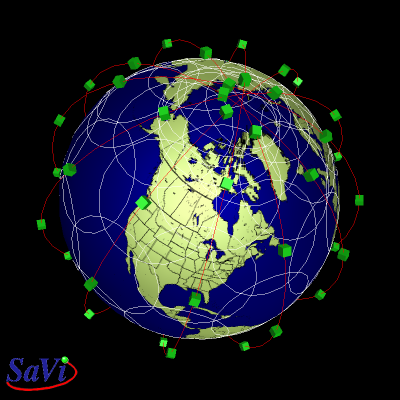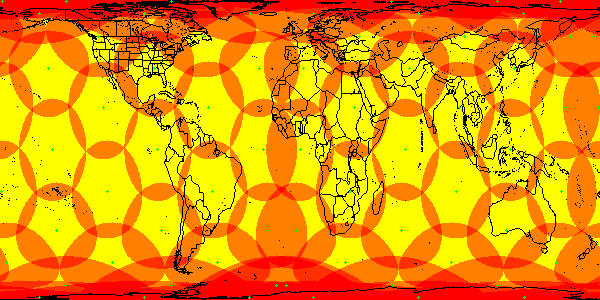
Overview:
Globalstar | ICO | Iridium | Orbcomm | Teledesic

|
Lloyd's satellite constellations Overview: Globalstar | ICO | Iridium | Orbcomm | Teledesic |

Full active Iridium constellation as modelled in SaVi
Transcript of Iridium Satellite LLC conference call (December 2000)
Overview of Iridium Satellite plans (news.com, 12 December 2000)
deorbiting appeared almost certain - but it's never too late to save Iridium.
|
User terminal information:
Official Iridium websites include:
Related sites include:
|
third-party Iridium sites include:
|
There are pages in other languages whose authors track Iridium: in Russian and in Spanish.
Iridium was originally developed by Motorola. Iridium LLC filed for bankruptcy protection, and was reborn as Iridium Satellite.
The Iridium constellation was originally planned to have 77 active satellites, and named after the element with 77 electrons by a Motorola employee (count the electron shells to get 77 when the atom is not bonded. Iridium also has an atomic number of 77 resulting from its 77 protons; the idea of electrons orbiting the nucleus being analogous to satellites orbiting the earth is tenuous, thanks to Heisenberg's uncertainty principle.)
Iridium was later redesigned to need fewer satellites - the 66 active satellites of today. (We're not counting in-orbit or ground spares.) But its name hasn't been changed to Dysprosium, the element with 66 protons and often 66 surrounding electrons whose root means 'bad approach'...
Iridium LLC filed with the FCC for the followup project - a 96-satellite system called MacroCell. This would have competed with Globalstar's GS-2 system of 64 satellites - if they got built. MacroCell might be going by the name Iridium Next or INX these days, but you're unlikely to see it mentioned anywhere outside old FCC filings.
Motorola donated an Iridium satellite to the Smithsonian National Air and Space Museum in Washington DC. It was apparently hung outside their Star Wars exhibit a long, long time ago, but now hangs in the aptly-named Beyond the Limits gallery.
Iridium filed for Chapter 11 bankruptcy on Friday 13 August 1999. Another
CFO has resigned and they're undergoing restructuring (Wired News)
The bankruptcy
filings are available in pdf - enter Last Name Iridium. You'll probably need javascript enabled.
Iridium's performance deadline extension was 31 May 1999, but they gained an extension to the end of June and Motorola was to make a decision in July, which in essence was 'we support provided everyone else does'.
Iridium's CEO has resigned. Their CFO announced plans to leave earlier. This is the first class action lawsuit over alleged financial irregularities. These people have class action lawsuits against a large number of firms, including an action against Orbital Sciences, but this case looks higher-profile. Other class-action lawsuits have since been filed in the wake of Iridium's quarterly results. (April 1999)
If you want idle financial speculation, please see either this discussion of the 1997 IPO, this general discussion, or Motley Fool. I'm not able to give an expert assessment on the level of financial knowledge displayed in those discussions, but I do hope it's higher than the general level of engineering knowledge I've seen displayed.
Wired summarises two weeks with an Iridium handset. (May 1999)
Summary in French of five days of using an Iridium phone with a GSM card. (5 May 1999)
How Iridium was doing is discussed in the transcript of a conference call (January 1999)
A review of the Iridium pager, which includes a report of a 2% connect rate for the Iridium phone. (ZDNet, 15 February 1999)
Iridium has announced that it had 3,000 customers at the end of 1998. Since it had 2,000 betatesters in September 1998, it was off to a slow start.
In-aeroplane telephony is seen as a market, so Iridium was to buy Claircom. That deal has since been called off. (23 June 1999)
Paging service was launched on 16 November 1998.
Voice service was due to begin on 23 September 1998, but that was delayed to November 1st to allow more time for testing. (The Leonid meteor shower hit November 17th, but had no major effect.)
Iridium had two thousand beta-testers, apparently. Iridium's then Chief Financial Officer stated that calls may not be charged for immediately if the system is not ready.
Apparently Iridium coverage was expected to be disabled and unavailable over Cuba, thanks to the US State Department. This has resulted in a marketing opportunity for ICO. One world (Cuba and coverage failures excepted), one phone. Where else will Iridium coverage be disabled? Given the speed of satellite motion, how accurate would the disabling of service be? Enquiring minds want to know!
Europe wants to wiretap Iridium, apparently. Complying with the world's governments is necessary for service; there's no end-to-end cryptography on calls.
Originally suggested US retail prices of $3,295 for a phone (with GSM or CDMA capability) and $695 for a pager.
"If we had a campaign that featured our product, we'd lose," John Windolph, Iridium LLC marketing director and protein shake drinker, is quoted as saying. (Quentin Hardy, To Sell a Phone, Iridium Plays To Fears of Being Out of Touch, Wall Street Journal, 4 June 1998, Wired 6.05)
The first review of an Iridium phone that I saw turned out to be in Norwegian; Scandinavians were early adopters of mobile phones. Try Norwegian articles discussing Iridium. (Dagens Telecom)
Here's an independent summary of the launches from Encyclopedia Astronautica.
If you want to track the satellites using the two-line element set format, here's a recent NORAD two-line element set for Iridium.
There's a regularly-updated downloadable TLE set from NORAD via NASA's OIG - log into their archive to get historical information. Orbitessera (mirror) may also be useful.
Mike McCants tracks the status of the constellations. As does Rod Sladen.
(The IRIDIUM 78 designation wasn't used, and that satellite was launched as IRIDIUM 03 instead. They're backfilling and reusing numbers, which makes comparing TLEs from different epochs and counting satellites a bit tricky.)
Doubts raised over September 23rd start of service (Wired News, 24 July 1998)
The fourteenth launch was a Chinese Long March, with two satellites, on 2 May and received very little publicity. (Washington Post article) That makes this Delta the fifteenth launch; it was scheduled for May 15th after delays, and finally launched on 17 May. Iridium now has the full constellation complement in orbit, ready for launch of service in September, barring failures.
The Delta launch was delayed while engineers investigate vapour found in the second stage during fuelling. But we're told that it won't delay the September service launch (Wired News, 28 April 1998)
Iridium
heads into home stretch (Wired News, 24 April 1998)
The constellation is nearing completion; Iridium say they're 80% deployed. (Wired News) No, 90% deployed (a later Iridium press release) - there was a Chinese Long March launch of two satellites on 25 March that received very little media coverage.
The eleventh launch was on a Delta from Vandenberg on 10:02 pm PST, March 29 1998.
On 4 September the first east-west intersatellite communications link, between satellites in different orbital planes (SV6 and SV10), was set up and tested with successful results. True space networking!
Two dummy satellites were launched on Long March as a test on 1 September 1997. (You'll see them mentioned as IRIDIUM MFS (mass frequency simulator) in the three-line element set for Iridium, where IRIDIUM 01 and 02 are missing.)
All other Delta II launches were grounded pending the inquiry results, and the launch was delayed indefinitely. However, the planned Russian Proton launches were unaffected by this. It's since been reported by the US Air Force that a split in the casing of one of nine solid rocket motors caused the accident.
Launch rescheduled to Saturday 10th (Satellite Journal International)
That's a lot of satellites. More than most of its competitors. 66 operational for full global coverage, in fact. But Teledesic planned more...

Iridium's satellite footprints at a moment in time, generated by SaVi
The footprints and the seam move over the earth
cylindrical projection
You can't just go out and pawn a constellation- Raymond Leopold, pawnbroker.